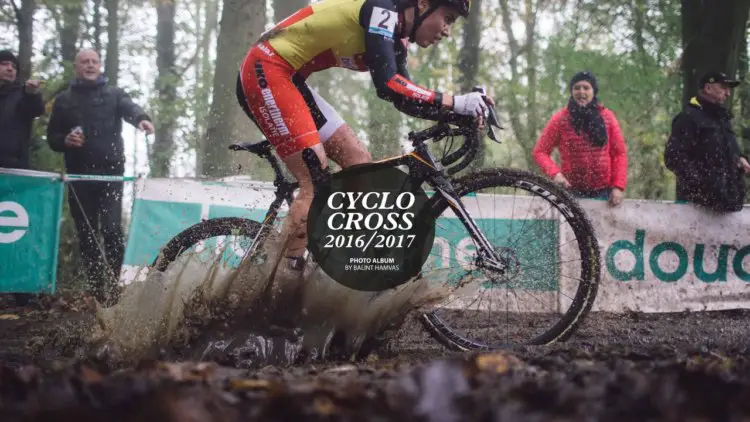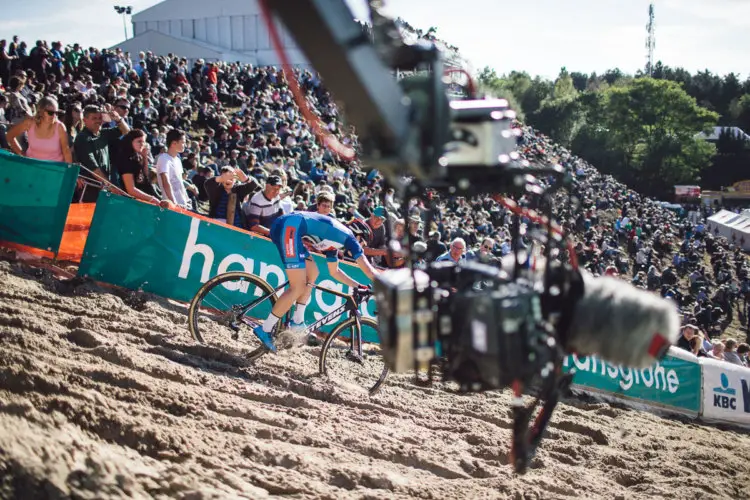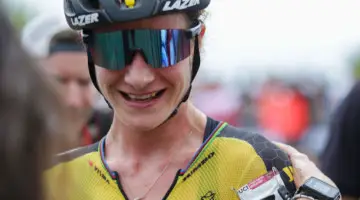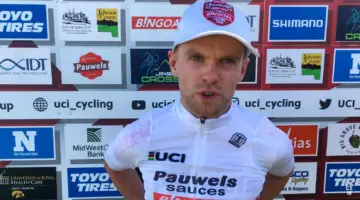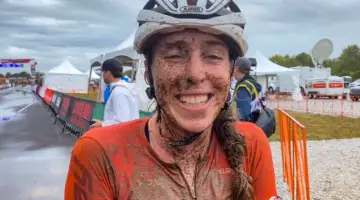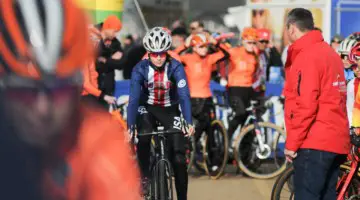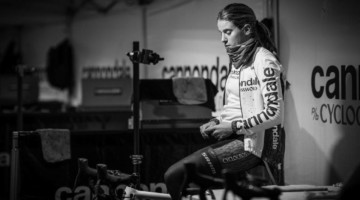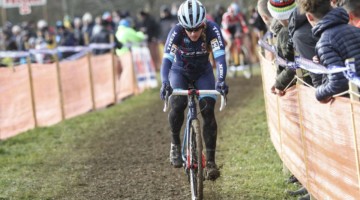Photographer Balint Hamvas bills his cyclephotos website as “Probably the best CX photography on the web.” We have featured some of Hamvas’ photos with our European race reports this season, and it is safe to say his humorous quip may very well be true.
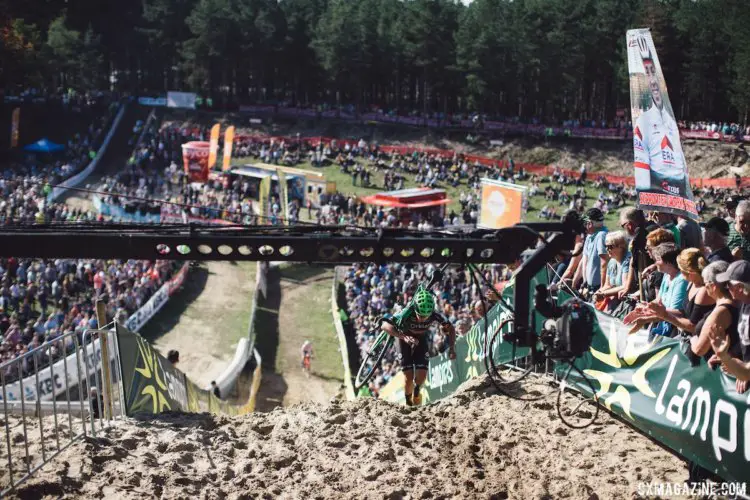
Hamvas brings a unique perspective to cyclocross photography. 2017 Superprestige Zonhoven. © B. Hamvas / Cyclocross Magazine
One thing that does set Hamvas apart as a photographer is the annual cyclocross retrospective he puts out each year. He published his first proper album after the 2011/12 season and has made it an annual tradition each year since.
The books not only provide a photographic review of the season, but Hamvas also offers his perspective on covering the races and includes feature stories that help bring the season to life.
His latest, the Cyclecross 2016/2017 Photo Album, is now available from his cyclephotos.co.uk website.
We briefly spoke with Hamvas about his latest album. He has also provided some sample images in the gallery below to show what you can expect.
Interview with Balint Hamvas About His Cyclocross 2016/2017 Photo Album
CXM: What is it about cyclocross that originally drew you to the sport?
Balint Hamvas: I used to be really into mountain biking and that is what I used to photograph and how I imagined my future as a photographer would go. I’m from Hungary originally and ’cross has never been big there. I do remember a photo from one of the Nationals in Hungary—it was taken on a football field, where a lonely and miserable cyclist rode on wet grass on his own. I didn’t see why would anybody care about cyclocross.
But something kept bugging me to check it out, so when the World Cup came near Hungary in 2008, I drove to Tabor to see it myself. It got me hooked immediately. It was so much more exciting than a mountain bike race; it was raw and intense.
I think it was the intensity that I fell in love with, and I think that is what keeps me excited after all these years.
CXM: You’ve done the books for several years now, how did the project start?
BH: A good friend of mine is a rally photographer and he’s done a few books. We were chatting about things back in 2009, and he jokingly said that I should do a book about cyclocross. First, I didn’t think much of the idea, but it stuck with me and I pulled together my first book in less than six weeks. Looking back, it was incredible that it all came together in such a short time, even though it was only 160 pages.
I wanted to sell it at the Worlds in Tabor, so I secured a booth in the expo area. The tricky thing was that there was only one week between Hoogerheide, which was that year’s final World Cup race, and Worlds, so in order to be able to do so, I had to print the book between the Hoogerheide race and Thursday of that week.
And all content was in three languages, so I had a Czech and a Dutch translator on call and they translated the text about Hoogerheide to their respective languages. The designer quickly slotted the photos into the layout and the printing started on Monday morning. To this day, I don’t know how, but the books were ready by Thursday evening.
Since Stybar won the World Cup that year, I put him on the cover and I thought it would sell like hotcakes. It didn’t. It was a massive flop and I had copies for years afterward. And let’s be honest, it wasn’t a great book.
But I loved that there was a visual chronicle of the season—or at least to a part of it—as the first book covered only the World Cup races. So when I finished my first full season in 2011/12, I felt like I really wanted to do another book. I wanted to do a proper book, so this was the first hardcover edition with 200+ pages and it fared a lot better and then I just kept going.
CXM: What is special about the 2016/2017 book?
It’s always the latest book that I like the most. I think the features and stories came out really well this year and John Coe, the designer, managed to lay out my photos really well.
CXM: One cool thing you do is add cyclocross stories. What is your favorite from this year’s book?
The John Meehan story, hands down. When Klaus Bellon, the writer, sent me the interview, I was speechless. He is such an extraordinary guy. He used to be an avionics engineer, then he retrained to became a pediatric surgeon and became a leader in robotic pediatric surgery.
Oh, and on the side, he puts on Jingle Cross, of which all profits go to a charity. It makes you feel a massive underachiever, but it is a fascinating story.
CXM: Your website humorously says “Probably the best cx photography on the web.” What sets you apart from other cycling photographers?
BH: Most photographers who regularly cover cyclocross are Belgian, and for them, it’s just another job. Today they are shooting Zonhoven, tomorrow they will be shooting a soccer game or tennis. They often try to optimize their movement and minimize the running around. I go to great lengths to find interesting or unique angles, even if it means that I have to run for the most of the sixty minutes. Whether I succeed or fail at that, I let others be the judge of that.
CXM: What was the highlight of the 2016/2017 season for you?
BH: The highlight for me was probably Worlds. It looked like it was going to be a very tame and easy course after a few preview videos that were posted the summer before. But it was anything but when I arrived the Thursday before the big weekend.
And every race was so exciting, so much drama. Great spectator turnout, a technical course and great racing, what else do you need?
Oh, and Sanne Cant won. Having seen her being there or thereabouts year after year, her win was poignant for me.
CXM: What have been your top three races to photograph or attend?
BH: First is probably the Koksijde Worlds in 2012. I will never forget the crowd at that race, people standing six, seven deep everywhere. It was also the top of the Belgian domination, with seven Belgians in the top ten. That weekend was bonkers on so many levels.
The second race must be Ronse in 2013. It was held just a few days after Amy Dombroski passed away and the mood was very quiet and sombre to begin with. I remember Nikki Brammeier’s poignant win very vividly, but just as vividly the fact that it was probably the worst weather I ever experienced at a race. It was maybe five degrees (Celsius), with a strong rain and wind all day long.
The press center was quite far away from the course, so we didn’t have time to go back to between races to warm up and dry the equipment out. In the last few laps of the men’s race, my cameras started to give up even under the waterproof covers and my fingers were so numb that I could barely turn the dials. It was the worst day on so many levels.
The third was probably Zonhoven in 2014. It was the day after Wout Van Aert narrowly defeated Sven Nys in the finishing straight of the Koppenbergcross, with the, probably unwilling, help of Jan Denuwelaere. The Nys fans were very upset about this.
De Kuil in Zonhoven, the massive sand bowl, can be intimidating in the best of times, but that day, when Denuwelaere started his descent during the first lap at the end of the field, the spectators started booing and it turned into this scary wall of sound, all directed at him. It was fascinating and slightly scary at the same time.
Cyclocross Magazine is receiving in-kind photos for this promotion.
Photo Gallery: Balint Hamvas’ Cyclocross 2016/2017 Photo Album Samples













